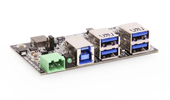The IoT is here and it’s growing rapidly. The Internet of Things (IoT) consists of the billions of devices that are connected to networks and the internet. From children’s toys to medical devices and sensors in refineries and factories, the IoT is part of our increasingly connected and productive world.
Take cell phones, for example, which are a major, but not the majority, the share of the IoT. There are an estimated 5.27 billion unique mobile phone users in the world (datareportal.com). Without factoring in users with multiple devices, that’s 5.27 billion devices connected to the internet right now. Yet, the devices we commonly think of as part of this new age of connectivity, are not the larger share of the growth currently taking place. Industrial devices will account for the majority of new connectivity in the coming years.
Industrial Growth in the IoT
It’s estimated there will be a staggering 55.7 billion devices in the IoT by 2025 (IDC.com). That means there will soon be almost seven times as many devices connected to the internet as there are people on the planet. All of the devices we come into contact on a day to day basis, from the gadgets in our smart homes to the FOB keys you tap to get into your gym or the office, can be part of this rapidly accumulating environment. But the growing wave of IoT in factories, utility services, and public services, such as medical settings, are quickly outpacing all other areas of expansion. In particular, the IoT is now seeing major growth “in application areas, such as asset management, remote servicing, operational intelligence, predictive maintenance, and remote monitoring” (Grand View Research).
Powering the New IoT
The growing IoT is a network of devices that are more technologically complex and require more power than the traditional IoT in order to operate. As this network of power-hungry devices expands, so does the demand for durable and reliable power sources. IoT endpoints, or the device that is connecting you, a service, or a machine to the internet, are at the very end of the branch – like the leaves of trees. From there, and as you work your way down the branch, you will find that each joint that joins the network together may require a power source, and may also require data transfer capabilities.
While much of IoT is often imagined to be low-powered or self-powered devices, such as key FOBs that run from coin batteries, increasingly “the IoT comprises a great diversity of device types, including smart sensors, data-logging devices, smart-building controllers, security devices (such as intruder detectors and networked cameras), and many other retail, enterprise, and infrastructure applications” (Tang, Benjamin). USB hubs are ideally suited for providing power to these connection and power delivery points because they are more reliable, precise, and durable than other options.
Why USB Will Power the IoT of the Future
This more complex version of the IoT is more technologically robust and often comes with more significant energy demands. USB hubs are possibly the safest, most efficient way to power the vast majority of this growing network. With protocols and power profiles that can optimize communication between end device and power source, industrial-grade USB offer sophisticated features that ensure each device receives exactly the amount of power it requires (Tang, Benjamin). Never too much, never too little, this reliable and precise supply of power ensures device longevity and efficiency.
In short, much of the technological advances that will affect industry and life over the next few years will be overwhelmingly powered by USB technologies. Coolgear is poised to meet these demands, and closely following the needs across a variety of industries.
Sources:
Datareportal.com. Digital Around The World. https://datareportal.com/global-digital-overview
IDC.com (2020, July 28). IoT Growth Demands Rethink of Long-Term Storage Strategies. https://www.idc.com
Chivers, Kyle. (2021). What is the Internet of Things? How the IoT works, and more. https://us.norton.com/internetsecurity-iot-what-is-the-internet-of-things.html
Tang, Benjamin and Qu, Mingyu. (2020, September 14). Powering IoT Endpoints Through USB or PoE Can Offer Greater Convenience and Economy.
https://www.powerelectronicsnews.com/powering-iot-endpoints-through-usb-or-poe-can-offer-greater-convenience-and-economy/
Grand View Research. (2021, June). Industrial Internet Of Things Market Size, Share & Trends Report. https://www.grandviewresearch.com/industry-analysis/industrial-internet-of-things-iiot-market




















